当前位置:
X-MOL 学术
›
ACS Catal.
›
论文详情
Our official English website, www.x-mol.net, welcomes your
feedback! (Note: you will need to create a separate account there.)
Computational Screening of Metal–Organic Framework-Supported Single-Atom Transition-Metal Catalysts for the Gas-Phase Hydrolysis of Nerve Agents
ACS Catalysis ( IF 11.3 ) Pub Date : 2019-12-31 , DOI: 10.1021/acscatal.9b03594 Matthew L. Mendonca 1 , Randall Q. Snurr 1
ACS Catalysis ( IF 11.3 ) Pub Date : 2019-12-31 , DOI: 10.1021/acscatal.9b03594 Matthew L. Mendonca 1 , Randall Q. Snurr 1
Affiliation

|
Recent studies have suggested that the gas-phase hydrolysis of nerve agents by Zr-based metal–organic frameworks (MOFs) may be limited by product inhibition resulting from strong bidentate binding of the hydrolysis products to the Zr6-nodes. A potential method to avoid this problem is to deposit single-atom catalysts on the nodes so that the products bind in a more favorable monodentate mode. Such catalytic active sites can be characterized with atomic precision, enabling detailed computational mechanistic studies. Thus, we used density functional theory to perform a comprehensive screening of single-atom transition-metal catalysts, in varying oxidation states, deposited on NU-1000 nodes for the gas-phase hydrolysis of the nerve agent sarin. By calculating the complete reaction pathways for M–NU-1000 systems, we discovered that the highest reaction barrier varies between catalysts, highlighting the need to consider more than a single reaction step when screening a large number of diverse materials. The single-metal catalysts are predicted to exhibit lower product desorption energies than unfunctionalized NU-1000. By comparing their relative turnover frequencies using the energetic span model, we identified several catalysts that are predicted to be more active than the parent MOF for this reaction. Finally, we explored periodic trends and molecular descriptors for their effect on catalytic activity.
中文翻译:

金属-有机骨架支撑的单原子过渡金属催化剂对神经剂气相水解的计算筛选
最近的研究表明,Zr基金属-有机骨架(MOF)对神经毒剂的气相水解可能受到水解产物与Zr 6的强双齿结合所引起的产物抑制作用的限制。-节点。避免此问题的潜在方法是在节点上沉积单原子催化剂,以使产物以更有利的单齿模式结合。可以以原子精度表征此类催化活性位,从而能够进行详细的计算机理研究。因此,我们使用密度泛函理论对沉积在NU-1000节点上的各种原子氧化态的单原子过渡金属催化剂进行了全面筛选,以进行神经毒剂沙林的气相水解。通过计算M–NU-1000系统的完整反应路径,我们发现催化剂之间的最高反应势垒有所不同,这突出了在筛选大量不同材料时需要考虑多个反应步骤的问题。预计单金属催化剂将比未官能化的NU-1000表现出更低的产物解吸能。通过使用能量跨度模型比较它们的相对周转频率,我们确定了几种催化剂,该催化剂被预测比该反应的母体MOF更具活性。最后,我们探讨了其对催化活性的影响的周期性趋势和分子描述子。
更新日期:2019-12-31
中文翻译:

金属-有机骨架支撑的单原子过渡金属催化剂对神经剂气相水解的计算筛选
最近的研究表明,Zr基金属-有机骨架(MOF)对神经毒剂的气相水解可能受到水解产物与Zr 6的强双齿结合所引起的产物抑制作用的限制。-节点。避免此问题的潜在方法是在节点上沉积单原子催化剂,以使产物以更有利的单齿模式结合。可以以原子精度表征此类催化活性位,从而能够进行详细的计算机理研究。因此,我们使用密度泛函理论对沉积在NU-1000节点上的各种原子氧化态的单原子过渡金属催化剂进行了全面筛选,以进行神经毒剂沙林的气相水解。通过计算M–NU-1000系统的完整反应路径,我们发现催化剂之间的最高反应势垒有所不同,这突出了在筛选大量不同材料时需要考虑多个反应步骤的问题。预计单金属催化剂将比未官能化的NU-1000表现出更低的产物解吸能。通过使用能量跨度模型比较它们的相对周转频率,我们确定了几种催化剂,该催化剂被预测比该反应的母体MOF更具活性。最后,我们探讨了其对催化活性的影响的周期性趋势和分子描述子。











































 京公网安备 11010802027423号
京公网安备 11010802027423号